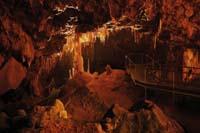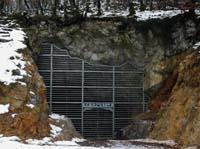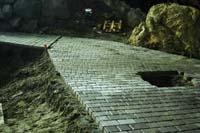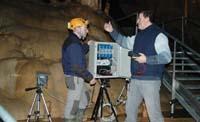At the bottom of the Earth on toes

Located on the slopes of the Sierra de Aralar, Mendukilo hosts another 800 caves and karst structures. This cave has no remarkable peculiarity compared to others, except for its large mouth and the breadth of its interior rooms. The shepherds have used the cave since ancient times to store the cattle, hence its name (mountain stable). They used the entrance hall, called Artzainzulo.
Later than the shepherds, but also beyond, the speleologists have entered the cave. The cartography of all the rooms of the cave was carried out in the early 1970s and, later, in 1972, the Government of Navarra decided to close the entrance with brick to prevent the entrance of the people and avoid the conduction of stalactites and stalagmites.
The first work in Mendukilo was the removal of the brick barrier. In fact, the inlet was the only hole that ventilated the cave and, once closed, left it without air or light.
Thus, Eneko Agirre, biologist and head of Mendukilo, highlights the change that has occurred in a short time in the walls of the Artzaintzulo: "When the brick wall was broken down, the walls were white, but now they are green. The microorganisms that live on the wall give it that color."

The microorganisms of the caves have an enormous capacity of adaptation. Without light they are chemotrophs, that is, they feed on the organic matter produced by other organisms. If there is light, energy is obtained through photosynthesis, such as plants. That is why the walls of Artzainzulo have been flush.
In other caves the same thing has also happened, but by the use of artificial light. In these cases, the phenomenon is known as “bad green” and the introduction of artificial light indicates that it has caused the alteration of the living beings of the cave.
Original status
Green disease is a good example of the importance of predicting the consequences of external agents. This requires a deep understanding of the existing conditions and further consideration of them. In fact, cave ecosystems are very vulnerable and any action can affect the ecosystem. Therefore, precautions must be taken to minimize damage.
Attention must be paid to geological, biological, climatological, anthropological aspects... It is not uncommon to find human remains in the caves, which for thousands of years have been the residence of men and women. These remains are true treasures, so it is the first thing studied in the caves.

The speleotopic that forms from the ceiling down is called stalactite. In the cave soil stalagmites form where water drops fall. The joining of stalactites and stalagmites leads to the formation of columns. And in addition, water generates other structures such as fences, flags, gours...
In Mendukilo there are examples of all these structures. But what to do so that the conditioning works do not hinder water work? To answer this question, they have decided to complete the tour with floating platforms. They fasten the platform using pillars located on both sides of the route. In this way, it is not supported on the ground, avoiding covering stalagmites, currents and others. In addition, the platform has holes in square shape so that the drops of water falling from the ceiling have no obstacles in their usual way.
Another feature of the platform is that it can be removed without any trace. In fact, as Agirre points out on numerous occasions, reversibility has been the priority in the choice of infrastructure elements and systems. "For us it is key that at any time everything can be removed and then no traces remain, or that, finally, it can be easily restored."
However, depending on the type of soil, other solutions may be suitable. For example, in Mendukilo itself a cobblestone has been placed in the areas where the pavement is clayey, on a gravel and a layer of sand. In this way, the drops of water falling above are inserted through the grooves between the stones and easily filter the next layer. In this way they have managed to condition the route without altering the natural path of the water or breaking the elements.
Also, of the five rooms that Mendukilo has left two out of the route, since access to them is not easy, so it would be necessary to break or modify various structures to install the infrastructure. They have not wanted to do so, so within the tourist cave, two areas have been protected.

Dark Light
Another important aspect of the caves is biological. The living beings of the caves are adapted to a unique environment and are also unique, as unique as they are vulnerable. In addition, many species are endemic, that is, they do not live anywhere else.
Knowing all this, before proceeding to its placement in any cavern, special attention must be paid to all living beings, in order to determine if there is any element to protect, either by being unique or in danger of extinction. According to Agirre, "in the samples made in Mendukilo there have been no endemic living beings, those that have been found are also in nearby caves. That does not mean that, of course, they are not taken into account."
Since the entrance of Mendukilo have taken into consideration the living beings of the cave, as proof of this is the aspect of the barrier that closes the cave. Entrance barriers to caves usually have vertical bars, while those of Mendukilo have horizontal bars. There is a reason for this: in the cave dwells a large horseshoe bat. This bat is unable to fly twisted and, with the horizontal wings, does not penetrate between the vertical bars.
On the other hand, for the tourist exploitation of the cave it is essential to clarify, but it must be done very carefully, especially to avoid the green condition. There are several systems to achieve this. For example, they have now invented a kind of resin to put it on the wall. The resin absorbs organic matter preventing the growth of microorganisms.

Conventional light bulbs have been installed for stage lighting, which remain on in a short time. The light helps the tourist during the visit. As the visitor progresses, the rear lights turn off and the previous lights turn on. In this way, each light does not take more than four minutes to be lit. This does not lead to green disease. To be sure, once a month they take a photo of the most vulnerable places and compare the colors to claim that nothing has changed.
Underground laboratory
Lighting, which also produces heat, also affects the cave climate. And, precisely, the climate also takes into account, since cave conditions are very stable and any change would be extremely dangerous.
In Mendukilo there are three weather stations to know the intrinsic conditions and analyze how they affect visits. In addition, they have another abroad to compare internal data with external data. Sensors measure rock and water temperature, carbon dioxide concentration, relative humidity and atmospheric pressure at some points. In addition, they plan to install an anemometer to detect air currents and another instrument to measure radiation.

The data collected by all sensors are collected on the computer, which facilitates comparisons and reviews. For example, before opening to Tourism, a study was initiated in which pilot visits were made to calculate the number of visitors that the cave could receive without altering the conditions. Above all, the number of people who can access it depends on the time they need to restore the values that have been modified.
According to Agirre, in Mendukilo the precautionary principle is maintained, allowing access to fewer visitors than expected. In fact, the investigation that began before its opening has not yet been completed, as it is two years. During this time they hope to know the consequences of the tourist exploitation of the cave and with it decisions will be made to continue protecting to the maximum the ecosystem of the cave. In the words of Agirre, "the management of the tuna is as important as the management of the tuna".
It is just one example of the tourist caves of Mendukilo, but more and more are trying to reconcile leisure with the care of the environment. Despite having a long way ahead, steps are being taken.






